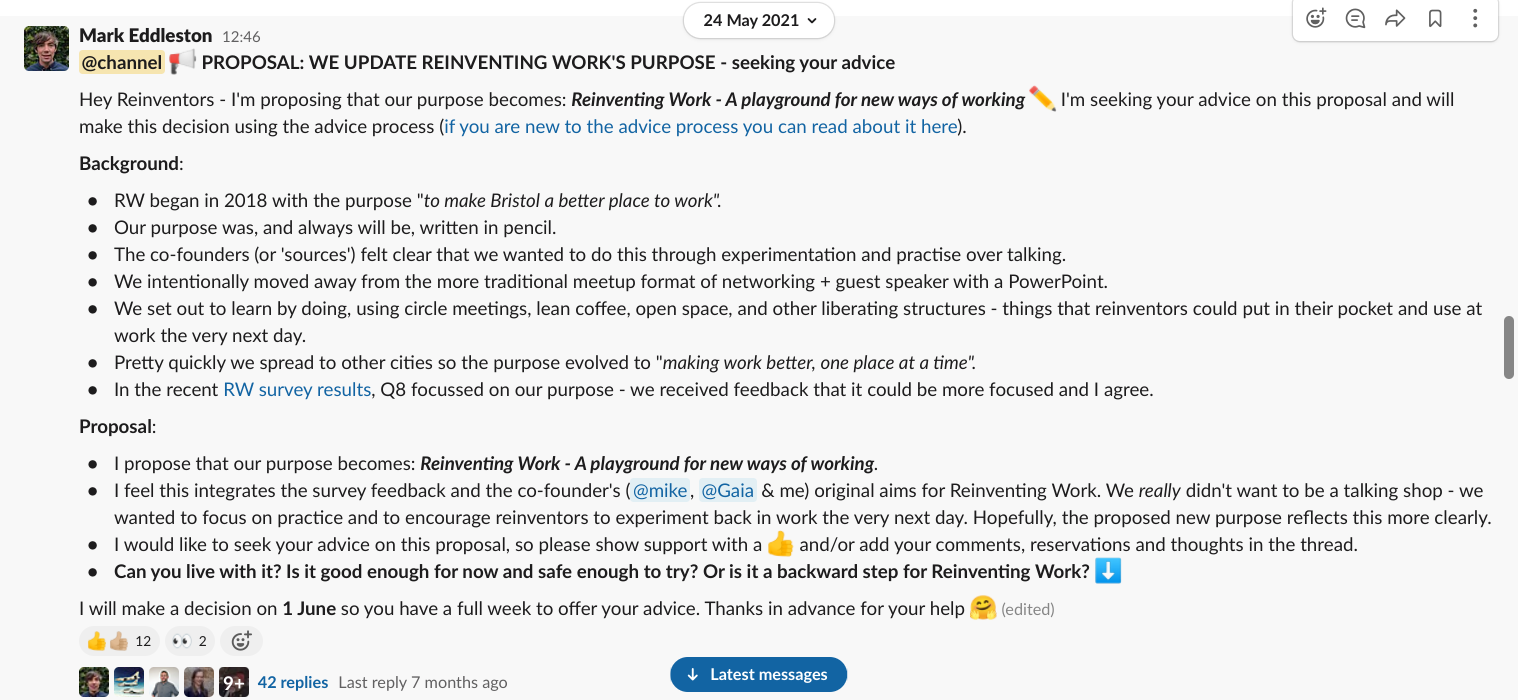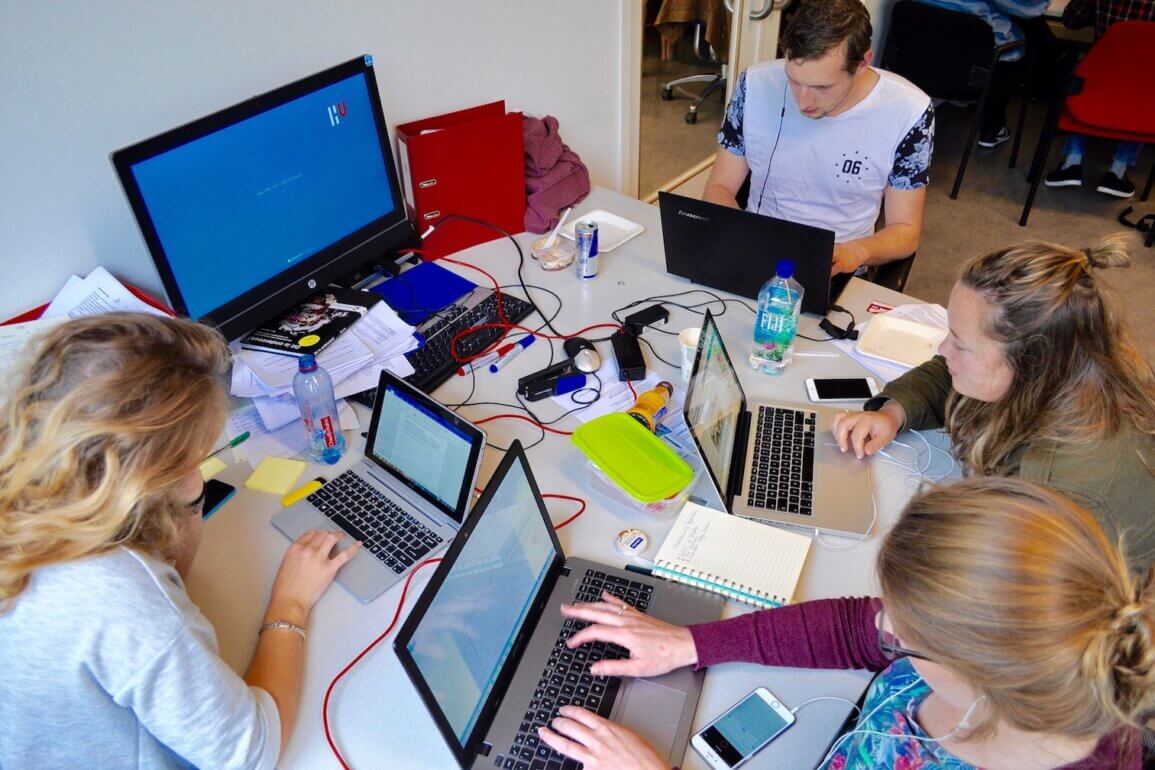By Mark Eddleston and originally published on newwaysofworking
Traditional decision-making 🧍♂️
In most organisations, centralised authority (such as the senior leadership team) holds much of the power. A few people at the top make most decisions, plus some lucky middle managers, while everyone else does as they are told. Employees need approval before they can do stuff that they haven’t been told to do. A few things may be approved here and there but, typically, lots of people feel frustrated and disempowered.
Decisions are too often made by people who are far away from the customer or information, while promising ideas are left on the shelf and forgotten. Ultimately, people stop making proposals and sharing ideas because they tend not to be approved. We grin and bear the baffling decisions from top brass and it’s annoying, to say the very least…
⚠️ Traditinal top down decision-making, where a few leaders hoard all the power, is one of the biggest sources of frustration felt by organisations.
Progressive decision-making 👩🏾🤝👩🏼🧑🏾🤝🧑🏻👩🏾🤝👩🏼🧑🏾🤝🧑🏻
Distributed decision-making on the other hand, is one of the tried and tested patterns found in progressive organisations. Recognising that it makes tremendous sense to move control to where the information and knowledge is, progressive organisations distribute the control that is traditionally hoarded by a few at the top.
They understand that the more people are involved in decision making, the more collective intelligence is harnessed, and the more empowered people are to make decisions, the happier and more engaged they will be.
*But this requires a structured process to ensure it doesn’t take ages and teams don’t fall into the trap of seeking deathly consensus – the best way to get nothing done quickly and end up with a compromise that suits nobody. One such process is ‘The Advice Process’ (created by Dennis Bakke), and it is wonderful.
The Advice Process: steps 🔢
- Take initiative — having noticed an issue or opportunity you have the responsibility to take the initiative. If you feel you are not best placed to make a decision then seek help from a colleague.
- Gather input — prior to proposing a decision you may choose to seek input in order to gather perspectives on the issue or opportunity.
- Seek advice on your proposed decision — once you have a decision or proposal in mind you need to seek advice from i) those with expertise on the subject matter, and ii) those who will be meaningfully affected by your decision (if you are unsure who they are then ask around and chat to your colleagues).
- Make a decision & tell people — having taken all advice into account, which you are obliged to do, you then make your decision and inform those who have given advice.
Et voila.
“Anyone can make any decision, so long as they are willing to take responsibility for the outcome, and they have first listened to input from anyone who will be affected, or who has relevant expertise”, Rich Bartlett.
Getting started 🧪
First and foremost, those who hold power must genuinely be willing to let some go. If they are then you can:
- Seek a group that is open to experimenting with the advice process – don’t impose the experiment top-down. Proceed only with the group’s consent.
- Share the advice process steps in writing. Feel free to copy and paste from here.
- Co-create a safe to try an experiment, e.g. let’s use the advice process for four weeks for all decisions and then hold a retrospective on how it went.
- Iterate the process during this timeframe – make it suit your team.
- Share your learnings with other teams – if it went well or shows promise hopefully others will be keen to give it a go!
Tips & things to remember 💡
I have used this wonderful process in various organisations and here are some pointers and things I learned along the way:
- Anyone can make any decision – provided they follow the advice process.
- If a decision does not impact others, you needn’t seek advice.
- No colleague, regardless of their role, can tell you what to decide – provided it is safe to fail. I.e. it won’t sink the company if it goes wrong, or in other words, it’s ‘above the waterline’.
- Aim to make quick decisions and for workable solutions rather than perfection. Set a deadline that advice is required by. If comments signal agreement, you can move quickly with your decision.
- If new perspectives emerge, you might choose to: i) amend your proposed decision; ii) establish a working group to refine it; iii) not pursue the idea; iv) convinced that you are closest to the information required to make the decision you may decide to make (or trial) the decision and to be responsible for the consequences.
- You will not agree with all the advice you receive and this is okay.
- If a decision affects all staff, you must seek advice from all staff – use technology to speed things up, so seek advice in Slack or MS Teams (see image below for an example in Slack).
- When communicating the decision, be clear about which stage in the process you are discussing (2, 3 or 4).
- Decisions needn’t last forever and can be reviewed at any time.
- With the advice process, you are aiming to create a culture of continuous improvement.
- Don’t blame colleagues if things don’t go as expected; help to put things right.
- If you notice a decision has been made without experts or those affected being consulted then this is an issue that you need to discuss with the decision-maker.
- *You won’t use the advice process perfectly the first time — keep practising, the results will be worth it.
Example 🧐
Below is a real example of the advice process in the Reinventing Work community. My proposal affected all members of the community (over 1,000 of us) so I used Slack to quickly gather the input of those who had advice to share:

So, share this with your colleagues and do try this at work! I would love to hear how you get on.
Republished with permission Featured Image added by Enlivening Edge Magazine.




